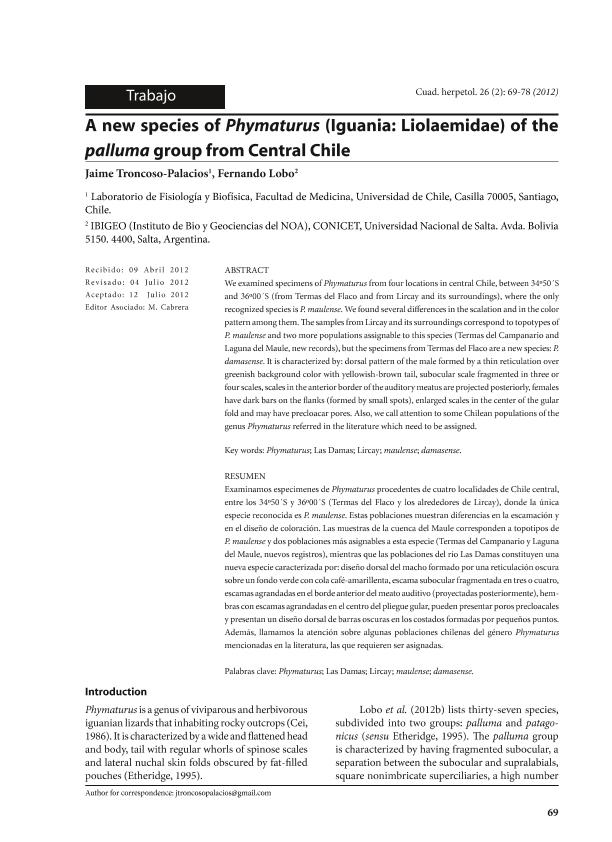Mostrar el registro sencillo del ítem
dc.contributor.author
Troncoso Palacios, Jaime
dc.contributor.author
Lobo Gaviola, Fernando Jose

dc.date.available
2018-07-13T15:39:05Z
dc.date.issued
2012-11
dc.identifier.citation
Troncoso Palacios, Jaime; Lobo Gaviola, Fernando Jose; A new species of Phymaturus (Iguania: Liolaemidae) of the palluma group from Central Chile; Asociación Herpetológica Argentina; Cuadernos de Herpetología; 26; 2; 11-2012; 69-78
dc.identifier.issn
0326-551X
dc.identifier.uri
http://hdl.handle.net/11336/52013
dc.description.abstract
We examined specimens of Phymaturus from four locations in central Chile, between 34º50´S and 36º00´S (from Termas del Flaco and from Lircay and its surroundings), where the only recognized species is P. maulense. We found several differences in the scalation and in the color pattern among them. The samples from Lircay and its surroundings correspond to topotypes of P. maulense and two more populations assignable to this species (Termas del Campanario and Laguna del Maule, new records), but the specimens from Termas del Flaco are a new species: P. damasense. It is characterized by: dorsal pattern of the male formed by a thin reticulation over greenish background color with yellowish-brown tail, subocular scale fragmented in three or four scales, scales in the anterior border of the auditory meatus are projected posteriorly, females have dark bars on the flanks (formed by small spots), enlarged scales in the center of the gular fold and may have precloacar pores. Also, we call attention to some Chilean populations of the genus Phymaturus referred in the literature which need to be assigned.
dc.description.abstract
Examinamos especimenes de Phymaturus procedentes de cuatro localidades de Chile central, entre los 34º50´S y 36º00´S (Termas del Flaco y los alrededores de Lircay), donde la única especie reconocida es P. maulense. Estas poblaciones muestran diferencias en la escamación y en el diseño de coloración. Las muestras de la cuenca del Maule corresponden a topotipos de P. maulense y dos poblaciones más asignables a esta especie (Termas del Campanario y Laguna del Maule, nuevos registros), mientras que las poblaciones del río Las Damas constituyen una nueva especie caracterizada por: diseño dorsal del macho formado por una reticulación oscura sobre un fondo verde con cola café-amarillenta, escama subocular fragmentada en tres o cuatro, escamas agrandadas en el borde anterior del meato auditivo (proyectadas posteriormente), hembras con escamas agrandadas en el centro del pliegue gular, pueden presentar poros precloacales y presentan un diseño dorsal de barras oscuras en los costados formadas por pequeños puntos. Además, llamamos la atención sobre algunas poblaciones chilenas del género Phymaturus mencionadas en la literatura, las que requieren ser asignadas.
dc.format
application/pdf
dc.language.iso
eng
dc.publisher
Asociación Herpetológica Argentina

dc.rights
info:eu-repo/semantics/openAccess
dc.rights.uri
https://creativecommons.org/licenses/by-nc-sa/2.5/ar/
dc.subject
Phymaturus
dc.subject
Las Damas
dc.subject
Lircay
dc.subject
Maulense
dc.subject
Damasense
dc.subject.classification
Otras Ciencias Biológicas

dc.subject.classification
Ciencias Biológicas

dc.subject.classification
CIENCIAS NATURALES Y EXACTAS

dc.title
A new species of Phymaturus (Iguania: Liolaemidae) of the palluma group from Central Chile
dc.type
info:eu-repo/semantics/article
dc.type
info:ar-repo/semantics/artículo
dc.type
info:eu-repo/semantics/publishedVersion
dc.date.updated
2018-07-11T14:09:02Z
dc.identifier.eissn
1852-5768
dc.journal.volume
26
dc.journal.number
2
dc.journal.pagination
69-78
dc.journal.pais
Argentina

dc.journal.ciudad
San Miguel de Tucumán
dc.description.fil
Fil: Troncoso Palacios, Jaime. Universidad de Chile; Chile
dc.description.fil
Fil: Lobo Gaviola, Fernando Jose. Consejo Nacional de Investigaciones Científicas y Técnicas. Centro Científico Tecnológico Conicet - Salta. Instituto de Bio y Geociencias del NOA. Universidad Nacional de Salta. Facultad de Ciencias Naturales. Museo de Ciencias Naturales. Instituto de Bio y Geociencias del NOA; Argentina
dc.journal.title
Cuadernos de Herpetología

dc.relation.alternativeid
info:eu-repo/semantics/altIdentifier/url/http://ppct.caicyt.gov.ar/index.php/cuadherpetol/article/view/1183
dc.relation.alternativeid
info:eu-repo/semantics/altIdentifier/url/http://ref.scielo.org/tpwy7w
Archivos asociados
